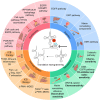The impact of tRNA modifications on translation in cancer: identifying novel therapeutic avenues
- PMID: 38476632
- PMCID: PMC10928989
- DOI: 10.1093/narcan/zcae012
The impact of tRNA modifications on translation in cancer: identifying novel therapeutic avenues
Abstract
Recent advancements have illuminated the critical role of RNA modifications in post-transcriptional regulation, shaping the landscape of gene expression. This review explores how tRNA modifications emerge as critical players, fine-tuning functionalities that not only maintain the fidelity of protein synthesis but also dictate gene expression and translation profiles. Highlighting their dysregulation as a common denominator in various cancers, we systematically investigate the intersection of both cytosolic and mitochondrial tRNA modifications with cancer biology. These modifications impact key processes such as cell proliferation, tumorigenesis, migration, metastasis, bioenergetics and the modulation of the tumor immune microenvironment. The recurrence of altered tRNA modification patterns across different cancer types underscores their significance in cancer development, proposing them as potential biomarkers and as actionable targets to disrupt tumorigenic processes, offering new avenues for precision medicine in the battle against cancer.
© The Author(s) 2024. Published by Oxford University Press on behalf of NAR Cancer.
Figures




Similar articles
-
The functions and modifications of tRNA-derived small RNAs in cancer biology.Cancer Metastasis Rev. 2025 Mar 12;44(1):38. doi: 10.1007/s10555-025-10254-6. Cancer Metastasis Rev. 2025. PMID: 40072687 Review.
-
Decoding the role of tRNA modifications in cancer progression.Curr Opin Genet Dev. 2024 Oct;88:102238. doi: 10.1016/j.gde.2024.102238. Epub 2024 Jul 31. Curr Opin Genet Dev. 2024. PMID: 39088870 Free PMC article. Review.
-
tRNA modifications: insights into their role in human cancers.Trends Cell Biol. 2023 Dec;33(12):1035-1048. doi: 10.1016/j.tcb.2023.04.002. Epub 2023 May 12. Trends Cell Biol. 2023. PMID: 37179136 Review.
-
Disruption of the RNA modifications that target the ribosome translation machinery in human cancer.Mol Cancer. 2020 Apr 2;19(1):70. doi: 10.1186/s12943-020-01192-8. Mol Cancer. 2020. PMID: 32241281 Free PMC article. Review.
-
RNA modifications as a common denominator between tRNA and mRNA.Curr Genet. 2021 Aug;67(4):545-551. doi: 10.1007/s00294-021-01168-1. Epub 2021 Mar 8. Curr Genet. 2021. PMID: 33683402 Review.
Cited by
-
Editorial: Translational control in cancer.NAR Cancer. 2024 Jul 23;6(3):zcae031. doi: 10.1093/narcan/zcae031. eCollection 2024 Sep. NAR Cancer. 2024. PMID: 39045152 Free PMC article. No abstract available.
-
Closing in on human methylation-the versatile family of seven-β-strand (METTL) methyltransferases.Nucleic Acids Res. 2024 Oct 28;52(19):11423-11441. doi: 10.1093/nar/gkae816. Nucleic Acids Res. 2024. PMID: 39351878 Free PMC article. Review.
-
Variation of tRNA modifications with and without intron dependency.Front Genet. 2024 Sep 4;15:1460902. doi: 10.3389/fgene.2024.1460902. eCollection 2024. Front Genet. 2024. PMID: 39296543 Free PMC article. Review.
-
Chemotherapeutic agents and leucine deprivation induce codon-biased aberrant protein production in cancer.Nucleic Acids Res. 2024 Dec 11;52(22):13964-13979. doi: 10.1093/nar/gkae1110. Nucleic Acids Res. 2024. PMID: 39588782 Free PMC article.
-
Toward the use of nanopore RNA sequencing technologies in the clinic: challenges and opportunities.Nucleic Acids Res. 2025 Feb 27;53(5):gkaf128. doi: 10.1093/nar/gkaf128. Nucleic Acids Res. 2025. PMID: 40057374 Free PMC article. Review.
References
-
- Morita M., Gravel S.P., Chénard V., Sikström K., Zheng L., Alain T., Gandin V., Avizonis D., Arguello M., Zakaria C. et al. . mTORC1 controls mitochondrial activity and biogenesis through 4E-BP-dependent translational regulation. Cell Metab. 2013; 18:698–711. - PubMed
-
- Holz M.K., Ballif B.A., Gygi S.P., Blenis J. mTOR and S6K1 mediate assembly of the translation preinitiation complex through dynamic protein interchange and ordered phosphorylation events. Cell. 2005; 123:569–580. - PubMed
Publication types
MeSH terms
Substances
LinkOut - more resources
Full Text Sources
Medical

